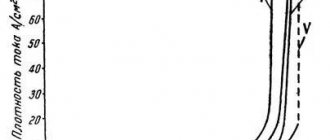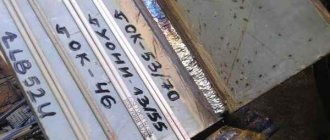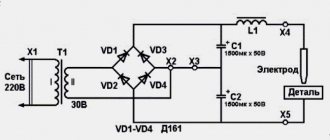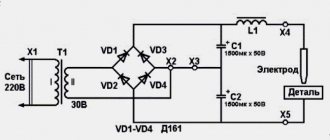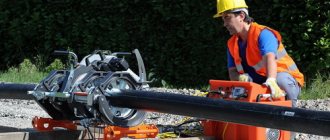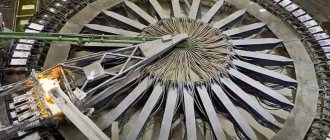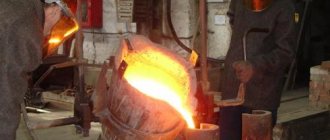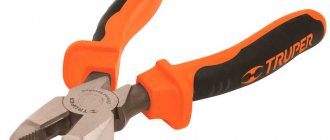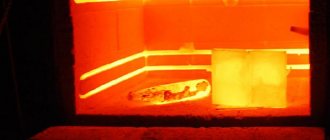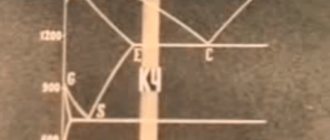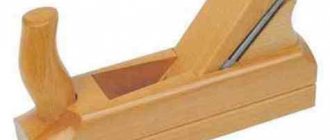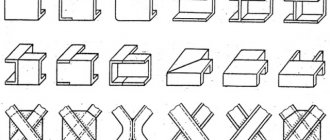On the modern welding equipment market, you can easily find almost any equipment that is suitable for even the most complex types of work. Among the most common equipment options preferred by modern welders, two main segments can be distinguished. These are welding inverters and semi-automatic machines. They are equally successfully used in both the private and industrial spheres. To understand what is better, a semi-automatic welding machine or an inverter, you need to familiarize yourself with the practical nuances of these devices.
Welding principle
Ordinary welding inverters are direct analogues of transformers, only more modern and compact. They are used for standard welding of metal parts using coated electrodes. This is one of the easiest ways to create a seam, which both beginners and more experienced welders can handle. The main driving force here is electric current, which melts the electrode and creates a weld pool. The protective function is performed by coating the selected electrode.
When using a semi-automatic, things are a little different. Although the main force here is electric current and it is the arc that serves to support the weld pool, welding wire is used as consumables. Accordingly, additional means must be used to protect it. Only flux-cored wire containing flux can be used without them, since it already contains the necessary substances. In other cases, shielding gas or additional flux may be used. This all turns out to be more complicated than using a conventional inverter. Thus, if in terms of priority what to choose, a semi-automatic or an inverter, ease of operation comes first for you, then the inverter will be more preferable.
Connection quality
One of the main indicators for professionals is the reliability of the resulting connection. With the method obtained with an ordinary inverter, the quality of the connection may suffer from the effects of external negative conditions. The weld pool is exposed to the influence of air and other extraneous factors. If you do not use this technique for welding aluminum, stainless steel and other difficult-to-weld metals and alloys, then this will be quite enough.
“Important! For a wide range of jobs, inverters are not so suitable.”
If when choosing which is better an inverter or a semi-automatic one, the quality of the connection is a factor, then it is better to choose a semi-automatic one. Due to the fact that protective gases can be used here, the quality of the connection increases significantly. This environment prevents various impurities from penetrating into the bathtub that could damage the seam. The connection is more homogeneous and due to the absence of coating, as one of the main risk factors, there is no large accumulation of hydrogen from moisture, there are no pieces of coating material, various foreign elements and other things. Experts recommend using just such a device for complex connections, be it an unusual alloy, metal or low thickness.
Features of the devices
If we consider how a semi-automatic machine differs from an inverter, then it is not only the type of consumables used that matters. It is also worth noting here that the semi-automatic machine has an automatic supply of consumables, which makes the welding process itself more convenient and faster. These are the main distinguishing features, since semi-automatic machines can also be built using an inverter system. Instead of a standard electrode holder, which serves as a conductor of current, the wire holder does not conduct current, as a special holder with infusible electrodes is used for this purpose. They create an electric arc and a weld pool into which filler material is supplied.
The remaining differences relate mainly to parameters, functions, sizes and other things that are inherent to a particular model. It could be:
- Current adjustment range;
- Adjustment step;
- The presence or absence of a cooling system;
- Shutdown system in case of overload;
- Dimensions;
- Carrying handles;
- Additional functions.
Advantages and disadvantages
The difference between a semi-automatic machine and an inverter creates such a situation that it is impossible to say unequivocally which of them is better. Here, each option has its own advantages and disadvantages. Inverter advantages:
- Relatively low cost;
- Availability of operation for a wide range of welders;
- Easy to carry and transport;
- There is no need to use gas or other additional materials;
- Quick preparation for use;
- Less risk of explosions and fires, as happens when working with gas;
- Large selection of models of varying power;
- Wide functional variety.
The advantages of semi-automatic machines include:
- High quality of created connections;
- The ability to easily work with parts that are difficult to weld under normal conditions;
- There is no risk of foreign elements entering the weld pool;
- It becomes possible to heat the workpiece before and after welding thanks to the presence of a burner.
Conclusion
The choice of a suitable welding machine that meets all requests depends only on the requests themselves. There are a huge number of models on the market, which allows you to select equipment for the desired procedures. If ordinary inverters can be classified as simple and universal models, then semi-automatic devices are more serious, designed to perform complex functions. If we divide everything conditionally, then the inverter turns out to be the best for use in small household work, and the semi-automatic machine turns out to be the leader when creating more critical seams.
The semi-automatic welding machine is an improvement on standard welding equipment. Thanks to the special design of the unit, the work process is significantly accelerated. Semiautomatic machines are widely used not only in factories, but also in small workshops.
Comparison of devices
To select equipment that is convenient for working at home and meets the needs of the master, you need to compare the main characteristics.
Welding joint quality
This is the main indicator of the performance of welding fixtures. When working with an inverter, the quality of the seam is affected by the air environment and other extraneous factors. For most metals being joined, with the exception of aluminum and stainless steel, its strength and tightness will be sufficient.
The quality of the welding joint is an important indicator of the performance of the welding machine.
The use of semi-automatic welding in a protective field provides higher reliability indicators. The gas prevents various impurities from penetrating into the weld pool. The joint will be uniform, because there are no pieces of coating, no accumulation of hydrogen from environmental moisture.
For welding thin materials, complex joints, and alloys, it is better to use semi-automatic equipment.
Economical
On the one hand, an inverter device is more expensive than a semi-automatic machine. But in terms of electricity consumption, it is more economical. It does not require purchasing a filled gas cylinder, which also reduces the cost of producing the seam.
We recommend reading: How to choose gas for welding
What's best for home
Choosing equipment for your home comes down to determining the scope of work to be done. If the master is not experienced enough in welding and plans only to use the device at home, then it is better to purchase a small compact inverter. In the case where the owner has the skills and permission to work with gas equipment, and is also considering the possibility of additional income from various types of repairs of metal structures, then a household semi-automatic device is recommended.
Specifications
Based on the parameters characteristic of each type of device, one can judge their functionality. For an inverter, these indicators are important:
- type of current at the output;
- supply voltage (220 V or 380 V);
- the magnitude of the starting current, which determines the diameter of the electrode used;
- power, which characterizes the current strength affecting the welding arc;
- open circuit voltage, which determines the ease of ignition;
- range of electrode diameters;
- dimensions and weight of the device.
For an inverter, the type of current output is important.
The strength of the welding current depends on the size. Therefore, the smaller the inverter, the less functional it will be.
When purchasing a semi-automatic machine, you should know the intensity of its future use. Depending on this, the following types of devices are selected:
- Household, designed for connection to a 220 V home network. During the welding process, such a device should be given time to cool down at intervals specified by the manufacturer in the instructions. They can operate in gas or gas-free mode using a cored wire electrode. They produce a current of no more than 200 A.
- Semi-professional, working in a protective gas cloud using the MIG/MAG method or MMA powder electrode. The current is a maximum of 300 A.
- Professional, designed for connection to a three-phase network. They weld metals using MMA, MIG and MAG methods, in pulse mode, with tungsten electrodes, in TIG mode (argon arc welding).
The mains voltage for which semi-automatic welding machines are designed is 220 V or 380 V. There are combined models. The ability of the electrical network to carry the load should also be considered. If it drops to a level of less than 150 V during welding, the semiautomatic device will turn off.
The main parameter on which the thickness of the welded metal depends is the current strength. Therefore, the following characteristics need to be taken into account:
- 150-200 A and electrodes with a diameter of 0.8-1.0 mm for workpieces of 5 mm;
- 250 A and wire 1.2-1.6 mm for parts thicker than 5 mm.
We recommend reading: The best semi-automatic welding machines
You should choose a device that has about 50 A in reserve to prevent overheating and extend service life. What matters is the duration of continuous load for which the device is designed. The duty cycle is expressed as a percentage. It is equal to 10 minutes, which is 100%.
This means that during this time the semi-automatic machine operates at maximum efficiency, and then turns off.
Features of the devices
When choosing welding equipment, you should pay attention not only to consumables, but also to the process of making the seam. With a semi-automatic machine, gas and wire are supplied automatically, which is more convenient than with an inverter.
When choosing welding equipment, pay attention to the process of making the seam.
Availability of additional functions
Semi-automatic welding machines and inverters are equipped with several auxiliary functions. Among them:
- Hot Start, or hot start. When welding starts, the current automatically increases, and after 0.5-3 seconds it decreases. This is important when the quality of the electrodes is poor, there is little experience and the connection of rusty structures.
- Arc Force, or arc stabilization. When it is activated during electrode sticking or arc extinction, the welding current increases, preventing a stop in the weld. Particularly important when welding on ceilings or using cellulose electrodes.
- Anti Stick is activated when the arc force is not active. At the moment of sticking, the current decreases to 1 A. The electrode is separated from the surface, and the device goes into normal mode. This function is useful when teaching beginners.
- VRD, which reduces the voltage to 12-24 V in the interval between touches of the electrode to the metal. At the moment of resuming welding, the indicators return to the working value.
Advantages and disadvantages of semi-automatic machines
Semi-automatic welding machines are popular not only among professionals, but also among home craftsmen, as they have a number of advantages over conventional welding machines. The main advantages of semi-automatic machines include the following:
- the ability to cook aluminum, cast iron, structural steel and other metals;
- The machine can cook both thin sheet steel (at least 0.5 mm) and thick;
- no need to sand the edges to a shine;
- the device is easily configured for different operating modes;
- high speed;
- affordable price;
- low toxicity of the generated smoke when compared with operation with conventional electrodes;
- wide gaps can be filled with metal;
- during operation, the weld pool is clearly visible, which is not filled with slag masses;
- the seams are distinguished by their tightness, which is important for connections for gases and liquids;
- when working with the MIG/MAG method, a small amount of splashes is created;
- the seam requires minor processing;
- ease of learning all parameters and settings for beginners.
Which device is better for home
When choosing welding equipment, the amount of work to be done is assessed. The final answer to the question of which welding machine is better for the home - an inverter or a semi-automatic machine - is obvious.
When there is a dacha, a country house, welders with experience and permission to work with gas equipment prefer to buy household semi-automatic devices of low power and light weight for personal use. This is an economical option, with it you can provide services to your neighbors: weld frames for greenhouses, doors, fencing bases, repair non-ferrous metal products. A break-in never hurts.
There is no need for beginners to purchase a semi-automatic device. For small household work with steel and aluminum, it is better to choose a small inverter power source with easy adjustment. It is not difficult to select the necessary electrodes; they are marked by type of coating and size.
Which is better - inverter or semi-automatic
If we compare the two types of devices, it becomes obvious that the inverter works with electrodes, and the semiautomatic device works with electrode wire, both powder-coated and copper-plated. In the latter case, it is necessary to use shielding gas to blow over the burning area of the electrode, which creates a better and more aesthetically pleasing seam than when welding with a conventional electrode. Semi-automatic machines are more suitable for working with stainless steel, aluminum and other “difficult” metals.
In addition, a semi-automatic machine can splice thin metal parts, for example, during car body repairs, which cannot be done with a conventional inverter. It is especially convenient to work with a semi-automatic device in hard-to-reach places, since the length of the electrode wire does not interfere with work. When working with an inverter, it is sometimes difficult to reach any connection point due to the length of the electrode. In such cases it has to be shortened, which takes time. The need to constantly replace the electrode greatly reduces labor productivity.
But inverters have a huge advantage over semi-automatic machines - they are mobile and compact in size. The device can be easily moved from one place of work to another, for example, when installing a long fence or installing advertising billboards. Therefore, the inverter can be considered a more universal device. A semi-automatic machine rather refers to stationary equipment that is used within a workshop or workshop area, since it has more mass than an inverter, and it is inconvenient to constantly move it along with the cylinder and hoses.
To summarize, we can say that the semi-automatic machine is more suitable for professional use when welding work is required on a regular basis. To make various connections at the household level, an inverter will be sufficient, especially if it is intended to be used occasionally.
Semi-automatic machines of inverter type
Not long ago, units appeared on sale that were a combination of an inverter and a semi-automatic device. An inverter semi-automatic welding machine, as the name implies, uses an inverter converter as a current source.
For reference! The inverter works on the following principle. The alternating current coming from the electrical network, passing through the diode bridge, is rectified. Next, the direct current passes through transistors, which convert it again into alternating, but high-frequency current. The high-frequency current is stepped down using a transformer, while the voltage decreases and the current increases. This current flows into the output rectifier, where it is again converted to DC.
Thanks to this technology, the dimensions of the unit are significantly reduced, and the high-frequency characteristics of the current have a positive effect on the stability of the welding arc. In addition, the main difference between inverters is their high efficiency, since energy is not wasted on heating the iron of a large transformer.
Inverter semi-automatic machines are used in large and small enterprises, in construction and automobile workshops. Using these devices, they weld any metals, both homogeneous and dissimilar; connecting parts of large thickness and welding thin sheet metals; continuous seams of long length, etc.
A semi-automatic inverter welding machine has its advantages over a conventional semi-automatic:
- welds are of the highest quality;
- excellent ergonomics;
- low power consumption;
- light weight;
- smooth adjustment of welding current;
- compact dimensions;
- there is protection against electrode sticking;
- “hot start” function;
- Pulse/Superpulse modes (used for working on thin sheet steel);
- arc force;
- high efficiency;
- built-in cooling system;
- there is protection against overheating;
- Thanks to microprocessor control, the device can carry out self-diagnosis, launch suitable welding programs, recognize torches, etc.
Also, inverter semi-automatic machines may have additional modes, for example, changing polarity or welding using the MMA method, that is, with piece electrodes, which significantly expands the capabilities of the unit.
Operating principle and distinctive features
First, a few words about operating modes. Semi-automatic machines confidently support the following modes:
- MIG – carbon dioxide welding;
- MAG - an argon cloud is created above the weld pool;
- some have an MMA (manual arc welding with coated electrodes) mode.
Semi-automatic welders are purchased for TIG - argon arc welding using a non-consumable electrode. Leading manufacturers produce combined professional devices that support all modes. But now we are talking about household equipment.
The main difference between welding inverters and semi-automatic machines is the type of additive used. The latter feed welding wire into the working area at a certain speed. When working with an inverter, electrodes with various types of coating are more often used, creating a protective layer of slag on the melt pool. It is more difficult to make an even suture bead using an electrode. Semi-automatic welding is beyond the capabilities of beginners; experience is required.
An ordinary welding inverter is a universal power source with a compact transformer and semiconductor converters. Equipped with additional functions:
- limiting the no-load voltage, maintains a stable arc in conditions of high humidity;
- hot start (Hotstart), providing easy ignition of the arc;
- protection against sticking of the electrode (Antistick), in case of a short circuit the electrode is re-ignited drop by drop;
- arc force (ArcForce), ensures stable welding.
It is convenient for beginners to work with the inverter; the equipment has simple settings, convenient knobs for adjusting the welding current.
A semi-automatic device is a complex device consisting of three main parts:
- current converter;
- in the mechanism that feeds the filler wire, a special cassette with guide rollers is mounted;
- gas supply systems to the working area to protect the melt from oxidation.
Technical parameters for choosing a semi-automatic machine
First of all, when choosing semi-automatic machines, you need to have an idea with what intensity they will be used, since the units are produced in 3 categories
- Household. They can be connected to a household power supply with a voltage of 220 V and are not designed for long-term use. After short intervals (indicated in the instructions), the device must be given time to cool down. Household models of welders produce a current within 200 A and can work both with and without the use of protective gases, that is, with flux-cored wire electrodes;
- Semi-professional. They can generate welding current up to 300 A. The devices use electrode wire paired with shielding gases. Welding can be carried out using the MIG/MAG method, as well as powder-coated electrode wire (MMA method).
- Professional. The units operate from a 380 V network and are designed for continuous operation. The current in them can reach 400 A. Semiautomatic machines can weld using MMA, MIG and MAG methods, as well as pulse welding and work with tungsten electrodes and argon arc welding (TIG).
Semi-automatic selection criteria
You should choose an inverter semi-automatic welding machine according to its technical characteristics, comparing them with the tasks that are supposed to be solved with its help. Let's consider the main parameters that influence the choice of device.
Maximum welding current. This is one of the main characteristics. The welding current, as well as the associated wire diameter, together determine the thickness of the metal penetration. Knowing the thickness of the metal that is supposed to be welded, using the data in Table 1, you can determine the required value of the welding current.
When choosing a machine based on welding current, it is advisable to provide a margin for this parameter. It is good if the maximum current value of the selected device exceeds that required by technology by at least 30%.
Acceptable operating mode. Manufacturers may designate this parameter differently. It is often called on-duration (ON) and is indicated as a percentage. The meaning of this characteristic is as follows. The work of the welding unit is usually divided into 10-minute cycles. The cycle duration is taken as 100%. For example, if a duty cycle of 60% is indicated, this means that during a cycle of 10 minutes the device should operate in welding mode for no more than 6 minutes.
Sometimes the operating mode is indicated for several values of welding current. For example: at a current of 150 Amperes, duty cycle 100%, at a current of 250 Amps, duty cycle 50%. This record means that with a welding current of 150 Amps, the machine can work for a long time without stopping, and at 250 Amps, only 5 minutes out of 10.
Based on this feature, as well as on the value of the welding current, machine models are conventionally classified into:
- Professional;
- Semi-professional;
- Amateur or household.
Review of popular semi-automatic models
Many manufacturers exhibit their products on the welding equipment market, and it is quite difficult for a beginner to choose a suitable semi-automatic welding machine from all the variety. The market is flooded with Chinese-made devices, which have a low cost, but are not of good quality, much less reliability. On the other hand, well-known brands from European and American manufacturers are quite expensive, and not every home craftsman decides to buy them for home use.
European manufacturers
Wester MIG 180. This inverter semi-automatic device was developed in Germany, but is produced in Chinese factories. But despite this, the semi-automatic machine has good build quality and high reliability. The manufacturer gives it a 3-year warranty, which also confirms the good quality of the product.
The device is household, consumes 7.5 kW of electricity and is capable of generating current up to 180 A. The minimum wire diameter that can be used on it is 0.6 mm. If you look at the reviews on the Internet left regarding the Wester MIG 180 semi-automatic device, there are practically no negative ones among them.
Telwin BIMAX 152 TURBO. This is a semi-automatic machine from an Italian manufacturer, which is a leader in the production of welding equipment.
